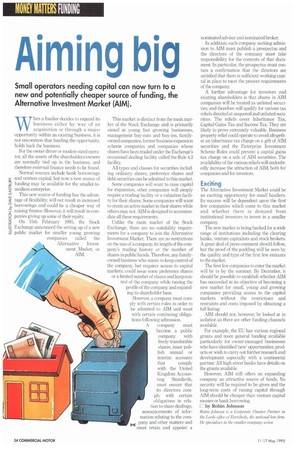Aiming bi
Page 36

If you've noticed an error in this article please click here to report it so we can fix it.
Small operators needing capital can now turn to a new and potentially cheaper source of funding, the Alternative Investment Market (AIM).
When a haulier decides to expand its business either by way of an acquisition or through a major opportunity within an existing business, it is not uncommon that funding the opportunity, holds back the business.
For the owner driver or modest-sized operator, all the assets of the shareholders/owners are normally tied up in the business, and therefore external finance needs to be found.
Normal sources include bank borrowings and venture capital, but now a new source of funding may be available for the smaller-tomedium enterprise.
This new source of funding has the advantage of flexibility, will not result in increased borrowings and could be a cheaper way of raising finance. However, it will result in companies giving up some of their equity.
On 15th February 1995, the Stock Exchange announced the setting up of a new public market for smaller young growing companies called the Alternative Investment . Market, or AIM. This market is distinct from the main market of the Stock Exchange and is primarily aimed at young fast growing businesses, management buy-outs and buy-ins, familyowned companies, former business expansion scheme companies and companies whose shares have been traded under the Exchange's occasional dealing facility called the Rule 4.2 facility.
All types and classes for securities including ordinary shares, preference shares and debt securities can be admitted to this market.
Some companies will want to raise capital for expansion, other companies will simply require a trading facility or a valuation facility for their shares. Some companies will want to create an active market in their shares while others may not. AIM is designed to accommodate all these requirements.
Unlike the main market of the Stock Exchange, there are no suitability requirements for a company to join the Alternative Investment Market. There are no restrictions on the size of a company, its length of the company's trading history or the number of shares in public hands. Therefore, any familyowned business who wants to keep control of the company, but requires access to capital markets, could issue some preference shares or a limited number of shares and keep control of the company while raising the profile of the company and expanding its shareholder base.
However, a company must com ply with certain rules in order to be admitted to AIM and must with certain continuing obligations following admission.
A company must become a public company with freely-transferable shares, must publish annual or interim accounts that comply with the United Kingdom Accoun ting Standards, must ensure that its directors comply with certain obligations in relation to share dealings, announcements of information relating to the company and other matters and must retain and appoint a nominated adviser and nominated broker.
In addition, each company seeking admission to AIM must publish a prospectus and the directors of the company must take responsibility for the contents of that document. In particular, the prospectus must contain a confirmation that the directors are satisfied that there is sufficient working capital in place to meet the present requirements of the company.
A further advantage for investors and existing shareholders is that shares in AIM companies will be treated as unlisted securities, and therefore will qualify for various tax reliefs directed at unquoted and unlisted securities. The reliefs cover Inheritance Tax, Capital Gains Tax and Income Tax. They are likely to prove extremely valuable. Business property relief could operate to avoid altogether an inheritance tax charge on a gift of AIM securities and the Enterprise Investment Scheme Rules could prevent a capital gains tax charge on a sale of AIM securities. The availability of the various reliefs will undoubtedly increase the attraction of AIM, both for companies and for investors.
Exciting
The Alternative Investment Market could be an exciting opportunity for small hauliers. Its success will be dependent upon the first few companies which come to this market and whether there is demand from institutional investors to invest in a smaller company.
The new market is being backed for a wide range of institutions including the clearing banks, venture capitalists and stock brokers. A great deal of press comment should follow, but the proof of the pudding will be seen by the quality and type of the first few entrants to the market.
The first few companies to enter the market will be in by the summer. By December, it should be possible to establish whether AIM has succeeded in its objective of becoming a new market for small, young and growing companies providing access to the capital markets without the restrictions and restraints and casts imposed by obtaining a full listing.
AIM should not, however, be looked at in isolation as there are other funding channels available.
For example, the EU has various regional grants and more general funding available particularly for owner-managed businesses who have identified 'new' opportunities, products or wish to carry out further research and development especially with a continental partner. All high street banks have details on the grants available.
However, AIM still offers an expanding company an attractive source of funds. No security will be required to be given and the long-term costs of raising capital through AIM should be cheaper than venture capital monies or bank borrowing.
El by Robin Johnson
Robin Johnson is a Corporate Finance Partner in the Leeds office of F,versheds, the national law firm. Ile specialises in the smaller company sector.




































































































